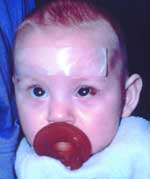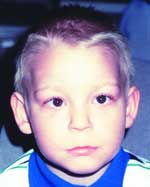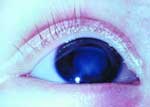Aphakia due to congenital cataracts or trauma is the most frequent indication for fitting very young children in contact lenses today. To insure proper development of the child"s visual system, it"s imperative to restore vision very soon after congenital cataract removal. Cataract surgeons generally don"t insert intraocular lenses in children under 2-3 years old during the lensectomy. The resultant aphakia is best corrected with contact lenses. Contact lenses may be worn indefinitely if it is determined that the eye doesn"t have the architecture to support an IOL the posterior capsule in children is very fragile. A secondary IOL may be implanted when the eye has developed and/or the child becomes contact lens intolerant.

Louise A. Sclafani, OD
The ideal pediatric aphakic lens
Although the corneas of aphakic eyes require less oxygen, high plus lenses and the extended sleep patterns of infants necessitate the need for high Dk/L lenses. It has been well established that the young cornea:

A searching nystagmus in bilateral cases following surgery may persist and has a less predictable prognosis.
- is generally steeper
- requires higher powers than the older aphakic population (due to shorter axial length)
- has smaller fissures.
Several contact lens manufacturers have designed lenses to accommodate pediatric aphakia: Bausch & Lomb, Flexlens, Alden, Continental, Kontur and Optech. I generally fit the Silsoft Lens by Bausch & Lomb because it is made of silicone, which allows for the highest oxygen transmissibility. Due to the Silsoft"s low water content, bacteria can"t penetrate the lens and the low absorption rate allows for use of post-op medications.
Fitting process
You can initiate the fitting process during the cataract surgery by taking corneal measurements using handheld topography or keratometry. Although this information is certainly helpful, it isn"t required when you"re fitting the aphakic infant -- unless you are fitting RGPs.
Most infants require the 11.3-diameter lens due to their small fissures. When fitting a premature infant (which is often the case), you"ll need much steeper base curves, such as 7.50 or 7.70. I stock Silsoft lenses in a variety of powers and curves so that I can dispense on the initial visit.

Contact lenses used in pediatric aphakia are easy to visualize if the optics are in the visual axis.
I allow the lenses to settle for about 20 minutes. You"ll know you"ve established the ideal physical fit once:
- you can observe 2mm movement
- there is no encroachment upon the limbus
- the optics are within the pupil.
Because these lenses are very easy to visualize on the eye without the use of a slit-lamp, fitting is easy. You can use the Burton lamp to evaluate the fit -- so long as the baby cooperates and is not afraid of the lamp.
Dispense the trial lens and instruct the parents that the infant should wear the trial lens continuously until the next visit, which is 24-48 hours later. When the patient returns, evaluate the fit, perform retinoscopy and stain the cornea. Order a lens with the appropriate power for nearpoint, which is the focus of an infant"s world. (Most of these lenses come in 3-diopter increments, so if you have to decide between powers, prescribe more plus because the infant world is up close.) Because it"s important to quickly establish an image on the retina and assuming that the physical fit is acceptable, have the infant continue to wear the trial lens until the appropriate power is available.
|
Considerations Specific to the Infant
|
|
Average Power Needed for the Aphakic Eye | |
|
| |
| 0-12 months | +29 D to +32 D |
| 12-24 months | +20 D to +26 D |
| > 2 Years | +12 D to +20 D |

All of the photos on these two pages are of this little boy, who has been in Dr. Sclafani"s care for the past 8 years.
Care of this special population
I allow continuous wear for 3-7 days with the use of daily non-preserved tears. Higher concentration hydrogen peroxide and several soft lens preservatives are contraindicated because they cloud the lens. The recommended system is CIBA"s Quick-CARE or Bausch & Lomb"s original ReNu.
These lenses are expensive, but I"ve found that they need to be replaced every 3-6 months due to deposits, loss or a need to change the fit. Hopefully, with the development of hyper-Dk frequent replacement lenses, the manufacturers will make these lenses available in aphakic powers.
The post-surgical management of the pediatric aphakic is just as important as the surgical procedure. We eyecare practitioners should establish ourselves with pediatric medicine so that we can become an integral part of the diagnosis and management of this special population.
Dr. Sclafani (lsclafan@uchospitals.edu), a 1989 graduate of the Illinois College of Optometry, is an Associate Professor of Clinical Ophthalmology and Director of Optometric Services and Contact Lenses at the University of Chicago.
 maximum oxygen permeability
maximum oxygen permeability 

